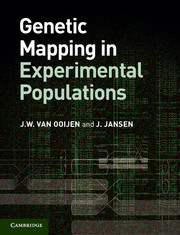Book contents
- Frontmatter
- Contents
- Preface
- 1 Introduction
- 2 Meiosis and genetic recombination
- 3 Estimation of recombination frequencies
- 4 Determination of linkage groups
- 5 Estimation of a genetic map
- 6 Criteria for the evaluation of maps
- 7 How to find the best map order
- 8 Outbreeding species
- 9 Mapping in practice
- Answers to exercises
- Index
Answers to exercises
Published online by Cambridge University Press: 05 August 2013
- Frontmatter
- Contents
- Preface
- 1 Introduction
- 2 Meiosis and genetic recombination
- 3 Estimation of recombination frequencies
- 4 Determination of linkage groups
- 5 Estimation of a genetic map
- 6 Criteria for the evaluation of maps
- 7 How to find the best map order
- 8 Outbreeding species
- 9 Mapping in practice
- Answers to exercises
- Index
Summary
Please note that the calculations of some of the exercises in this book are demonstrated with MS-Excel spreadsheets (.xls). These are included in the set of files that are available for downloading at the Cambridge University Press web site at http://www.cambridge.org/9781107013216.
Exercise 3.1.
First determine, for each combination of markers, which genotype classes are recombinant and which non-recombinant. Here, combinations of AA with Aa are recombinant, whilst combinations of AA with AA and Aa with Aa are non-recombinant. Next, determine the total number of recombinant individuals and divide this by the total number of individuals with known genotype:
K–L: r̂ = (4 + 5 + 8 + 5)/100 = 0.22
K–M: r̂ = (0 + 5 + 8 + 1)/100 = 0.14
L–M: r̂ = (0 + 4 + 5 + 1)/100 = 0.10
Exercise 3.2.
First determine, for each combination of loci, which genotype classes are recombinant and which non-recombinant. Here, combinations of a with h are recombinant, whilst combinations of a with a and h withare non-recombinant. Any combination with an unknown observation, ‘–’, must be subtracted from the 164 individuals to determine the total number of individuals with known genotype, as these combinations cannot be classified as recombinant nor as non-recombinant. Next, determine the total number of recombinant individuals and divide this by the total number of individuals with known genotype. The easiest way to do this is tallying the individuals in a 3 × 3 contingency table. If you have access to the data in a computer spreadsheet, you can achieve this easily with pivot tables.
Information
- Type
- Chapter
- Information
- Genetic Mapping in Experimental Populations , pp. 139 - 154Publisher: Cambridge University PressPrint publication year: 2013
